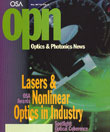Feature Articles
Profiling Laser Coding in the Packaging Industry
Laser marking is becoming the preferred means of coding product packages by many industries, gaining dominance over traditional coding technologies. Marking systems using either sealed CO2 or TEA CO2 lasers code an array of package and container materials. The reasons for coding, how laser marking works, the effects on different materials, and which type of laser is most appropriate for a given job are discussed by Bruton, all in terms of real-world applications.
by Natalie J. BrutonThe Emergence of Nonlinear Optics in the Factory
Nonlinear optical techniques may provide the competitive edge for quality control and enhanced manufacturability in the ever-challenging industrial arena. To this end, Pepper highlights in-process inspection of industrial components using laser ultrasonics with adaptive photodetectors, real-time pattern recognition and classification, and compensated fiber-based systems for high-brightness, high-average power laser beam delivery systems for material processing.
by David M. PepperOptical Coherence Tomography for Biodiagnostics
Novel coherence-domain imaging techniques provide the capability for rapid, noninvasive imaging of microscopic sub-surface structures and blood flows in living biological tissues. The authors describe recent advances in optical coherence tomography (OCT), optical coherence microscopy (OCM), and color Doppler OCT (shown above) as means to provide the medical profession with new diagnostic tools.
by Joseph A. Izatt, Manish D. Kulkarni, Kenji Kobayashi, Michael V. Sivak, Jennifer K. Barton, and Ashley J. WelchWrite a Book and Watch Your Company's Profits Soar
Smith provides some practical advice for how to put down on paper all the business wisdom that you carry in your head.
by Martin R. SmithScatter-minded: Part I
When demonstrating lasers to children, I like to delight them with the simple chalk dust scattering demonstration familiar to many of us. I direct a beam across the room, using caution to make sure the beam doesn't strike anyone in the eye, and have a volunteer walk along the beam while patting dusty erasers together (see image on page 63). As the children observe the scintillating beam, I ask them to tell me what's happening. Why does the chalk dust allow them to see the beam? What's wrong with all those sci-fi movies where we see brilliant visible laser beams zipping through the vacuum of space?
by Michael E. Knotts


![A multiplexed image of a human tonsil acquired. [NIAID] using the iterative bleaching extends multiplexity (IBEX) method.](https://opnmedia.blob.core.windows.net/$web/opn/media/images/articles/2024/0424/departments/202404-cover-web.jpg?ext=.jpg)
